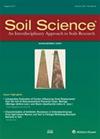面对气候变化的森林石灰化:恢复性石灰化对德国成熟森林土壤有机碳的影响
4区 农林科学
Q2 Agricultural and Biological Sciences
引用次数: 0
摘要
摘要森林石灰化是一种管理工具,已经并将继续在北欧广泛使用,以抵消人为硫和氮(N)沉积造成的酸化过程。在本研究中,我们量化了石灰如何影响土壤有机碳(SOC)储量,并试图理清调节土壤净碳(C)通量的经常相互矛盾的过程的机制。采用配对样地试验设计,对德国各地成熟阔叶林和针叶林28个试验点在60 cm土壤深度上有石灰样地与相邻无石灰样地的土壤有机碳储量进行了比较。分析了配对试验区子集的历史土壤数据,以评估1990年至2019年对照和石灰样地有机碳储量的变化情况。总体而言,我们发现在对照样地,森林地面C储量是随时间积累的。然而,石灰化在很大程度上抵消了L/Of层中有机层的积累,并且在石灰化样地,森林地面碳储量随时间保持不变。反过来,这意味着养分保持流动,而不是束缚在土壤有机质复合体中。配对样地分析结果表明,石灰样地的森林地面碳储量显著低于对照(−34%,−8.4±1.7 Mg C ha−1),但对矿质土的有机碳储量影响不显著。在森林底层,有机碳储量随着pH值的增加呈指数下降,这表明石灰诱导的生化环境改善促进了有机质的分解。然而,对于林地和矿质土壤,地下变化的幅度和方向直接取决于固有的立地特征,即森林类型(针叶林与阔叶)、土壤pH、土壤质地和土壤SOCstocks。另一方面,有机碳储量的减少通常被促进碳积累的其他过程所抵消,如森林生产力的提高或碳稳定性的增加,这相应地转化为有机碳储量的整体可变响应,特别是在矿质土壤中。最后,我们在三个试验点测量了土壤二氧化碳(CO2)和土壤甲烷(CH4)通量。在这里,我们发现(1)石灰在长期内使CH4吸收加倍;(2)土壤有机质矿化过程对石灰化反应迅速,尽管不同地点CO2冲刷的持续时间和大小不同;(3)在测量期间(使用稳定同位素方法确定),石灰产生的二氧化碳对二氧化碳总排放量的贡献很小。本文章由计算机程序翻译,如有差异,请以英文原文为准。
Forest liming in the face of climate change: the implications of restorative liming for soil organic carbon in mature German forests
Abstract. Forest liming is a management tool that has and continues to be used
extensively across northern Europe to counteract acidification processes
from anthropogenic sulfur and nitrogen (N) deposition. In this study, we
quantified how liming affects soil organic carbon (SOC) stocks and attempt
to disentangle the mechanisms responsible for the often contrasting
processes that regulate net soil carbon (C) fluxes. Using a paired plot
experimental design we compared SOC stocks in limed plots with adjacent
unlimed control plots at 28 experimental sites to 60 cm soil depth in mature
broadleaf and coniferous forests across Germany. Historical soil data from a
subset of the paired experiment plots were analyzed to assess how SOC stocks
in both control and limed plots changed between 1990 and 2019. Overall, we found that forest floor C stocks have been accumulating over
time in the control plots. Liming however largely offset organic layer
buildup in the L/Of layer, and forest floor C stocks remained unchanged
over time in the limed plots. This, in turn, meant that nutrients remained
mobile and were not bound in soil organic matter complexes. Results from the
paired plot analysis showed that forest floor C stocks were significantly
lower in limed plots than the control (−34 %, −8.4 ± 1.7 Mg C ha−1) but did not significantly affect SOC stocks in the
mineral soil, when all sites are pooled together. In the forest floor
layers, SOC stocks exhibited an exponential decrease with increasing pH,
highlighting how lime-induced improvements in the biochemical environment
stimulate organic matter (OM) decomposition. Nevertheless, for both forest
floor and mineral soils, the magnitude and direction of the belowground C
changes hinged directly on the inherent site characteristics, namely, forest
type (conifer versus broadleaf), soil pH, soil texture, and the soil SOC
stocks. On the other hand, SOC stock decreases were often offset by other
processes that fostered C accumulation, such as improved forest productivity
or increased carbon stabilization, which correspondingly translated to an
overall variable response by SOC stocks, particularly in the mineral soil. Lastly, we measured soil carbon dioxide (CO2) and soil methane
(CH4) flux immediately after a re-liming event at three of the
experimental sites. Here, we found that (1) liming doubles CH4 uptake
in the long-term; (2) soil organic matter mineralization
processes respond quickly to liming, even though the duration and size of
the CO2 flush varied between sites; and (3) lime-derived CO2
contributed very little to total CO2 emissions over the measurement
period (determined using stable isotope approaches).
求助全文
通过发布文献求助,成功后即可免费获取论文全文。
去求助
来源期刊

Soil Science
农林科学-土壤科学
CiteScore
2.70
自引率
0.00%
发文量
0
审稿时长
4.4 months
期刊介绍:
Cessation.Soil Science satisfies the professional needs of all scientists and laboratory personnel involved in soil and plant research by publishing primary research reports and critical reviews of basic and applied soil science, especially as it relates to soil and plant studies and general environmental soil science.
Each month, Soil Science presents authoritative research articles from an impressive array of discipline: soil chemistry and biochemistry, physics, fertility and nutrition, soil genesis and morphology, soil microbiology and mineralogy. Of immediate relevance to soil scientists-both industrial and academic-this unique publication also has long-range value for agronomists and environmental scientists.
 求助内容:
求助内容: 应助结果提醒方式:
应助结果提醒方式:


